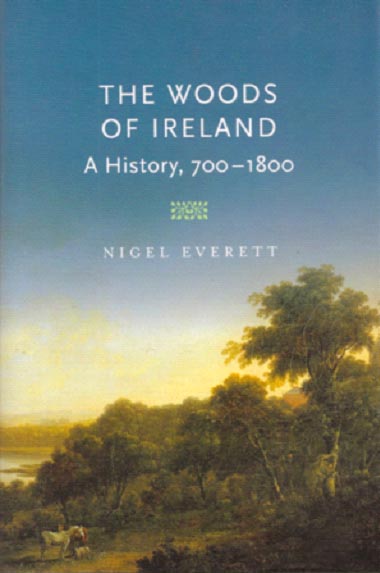 In these days of steel, concrete and plastic we have forgotten what a fundamental raw mat-erial timber once was. It was crucial to shipbuilding until the first iron-hulled vessels of the 1800s; buildings, even when of stone or brick, needed timber for their roof crucks and beams; charcoal fuelled early industry; wooden barrel staves were essential for the shipment of a range of commodities; bark was requisite for the widespread tanning industry. The great woods that once stretched over Ireland were indispensable resources, sometimes squandered for political or economic reasons, sometimes carefully husbanded.
In these days of steel, concrete and plastic we have forgotten what a fundamental raw mat-erial timber once was. It was crucial to shipbuilding until the first iron-hulled vessels of the 1800s; buildings, even when of stone or brick, needed timber for their roof crucks and beams; charcoal fuelled early industry; wooden barrel staves were essential for the shipment of a range of commodities; bark was requisite for the widespread tanning industry. The great woods that once stretched over Ireland were indispensable resources, sometimes squandered for political or economic reasons, sometimes carefully husbanded.
As Nigel Everett recounts in The woods of Ireland: a history, 700–1800, Irish timber, particularly oak, was once greatly prized. It was used for the roof of Salisbury Cathedral in the thirteenth century, as well as for Canterbury and Exeter cathedrals, and it was exported to the Continent. Irish timber was important for shipbuilding, and items such as ‘oars, oar-blades, hoop staves, poles, laths, beams, small beams, ingle boards and ship planks’ were shipped from south-eastern ports to the English market. The extensive woods of Shillelagh, Co. Wicklow, were exploited over the centuries; in the seventeenth century beams from Shillelagh were used in the re-roofing of Dublin’s St Patrick’s Cathedral.
The main theme of Everett’s scholarly and comprehensive work is a much larger one, however, than the straightforward story of the management and exploitation of Irish woods before 1800. He challenges the persistent belief that Ireland’s woods owed their decline to deliberate destruction by the English, the view that Ireland ‘was covered in trees until the English came and cut them down’. Everett’s purpose is to show that the real story is far more complex: ‘The history of Irish woods is replete with uncertainties, misapprehensions and elements of paradox’, and he poses the question ‘… when was the country denuded of its forests and who was chiefly responsible?’
In early Ireland trees were venerated, but were regarded as expendable when military considerations were paramount; ‘warriors hack passages through dense forests, drive their chariots over mighty oaks, or uproot … trees to serve as cudgels’. The ancient Irish law-texts outlined general standards for woodland maintenance, however, and apparently already included regulations to protect hazel coppices—coppiced wood, particularly hazel branches, has always been a significant raw material.
Felling of woodland intensified after the arrival of the Anglo-Normans in order to facilitate agriculture and settlement, and the settlers also needed trees cleared for security reasons; they went in constant fear, not unjustified, of Irish outlaws and rebels sheltering in the wastelands of forest, bog and mountain. In the first years of settlement, Henry II attacked Ireland’s forests and bogs ‘as barriers to conquest and repositories of rebellion’. Of the sixteenth century Everett writes that ‘Historians of Irish woods have been much taken with the idea of an arboreal “holocaust” ordered by a spiteful Queen Elizabeth’. He suggests, however, that orders for tree demolition may have been honoured more in the breach than in the observance.
It is the seventeenth and eighteenth centuries that take up the greater part of this book, though, with chapters that include ‘The king’s woods, 1603–40’, ‘The propagation of timber, 1660–1700’, and ‘Reclaiming Ireland, 1700–60’. Everett concludes that ‘It might even be argued that, far from carelessly wrecking a great arboreal patrimony, the English conquest and the rising ascendancy introduced conservative standards of forest management until then neglected’.
A section of colour plates complements the text. The English soldier Captain Thomas Lee is delightfully posed in 1594 as a ‘very superior style of woodkerne’ before an oak tree and a prospect of distant woods, wearing an elaborate shirt and doublet but bare-legged and barefooted. A map of 1598 shows woodland on an estate in County Cork, but with most of the land in cultivation. There are images from the eighteenth century, the great period of demesne paintings, also discussed in the short final chapter, ‘Demesne portraits’. The trees surrounding Powerscourt waterfall appear in an engraving by Giles King, although this is a modest delineation compared with the stately trees shown in paintings of the waterfall by George Barret, which Everett considers too romanticised. The richly planted demesne of Dawson Grove, Co. Monaghan, is displayed idyllically in views by Thomas Roberts, and a painting by Paul Sandby shows the thickly wooded character of the River Blackwater’s banks at Dromana.
Nigel Everett has cast a wide net, drawing his material from very diverse fields, from the early annals to eighteenth-century tours and modern historiography. The bibliography is extensive. And the story has resonances in the modern world. Deforestation continues worldwide for the same reasons as once operated in Ireland, from the military tactics that caused the use of Agent Orange during the Vietnam War to the drive for commercial gain respon-sible for the devastation of tropical rainforests.
Here in Ireland we are, perhaps, in a state of equilibrium, where commercial interests are balanced by aesthetic and recreational ones. The furore in the late twentieth century over the proposed sale of the remaining Shillelagh woods demonstrates the power of modern public opinion. The establishment of a Native Woodlands Scheme in 2011 and the work of the Tree Council of Ireland over recent decades show our positive engagement today with Ireland’s arboreal heritage. Nigel Everett’s definitive study provides fuel for the understanding of this heritage.

